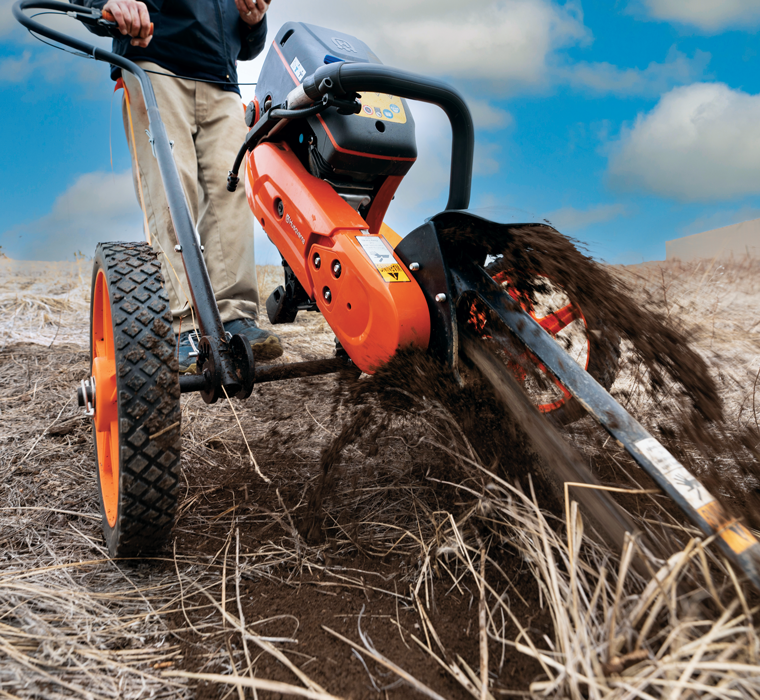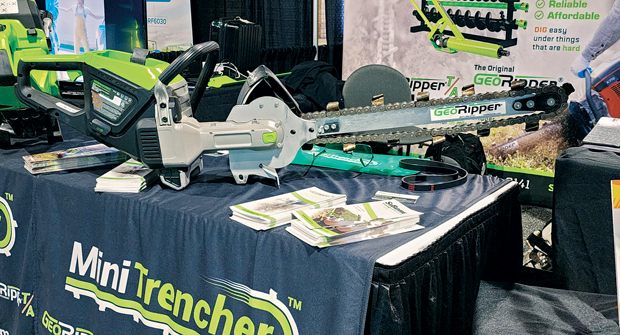The 2024 Irrigation Show and Education Weekend happened in Long Beach, Calif., last month, and amidst all the new pumps, valves and controllers attendees have come to expect, one technology was cutting its way above the rest.
Handheld trenchers, showcased at the MiniTrencher and GeoTrencher booths, have become another hot commodity for landscaping and irrigation professionals due to their versatility.
“It’s a lightweight tool that does a lot by itself and does a lot in conjunction with other equipment that a landscaping crew would have,” says John Hatch, technical director for GeoTrencher. “But unlike other larger machines, it doesn’t take up room on the trailer.”
Hatch describes them as a dirt chainsaw, meaning they are easy to hold and control while slicing into the ground. He says a handheld trencher is a great way to not only make a ground incision for laying pipes or installing irrigation lines, but also for cutting roots, installing root barriers, laying low-voltage cables and other jobs that require a smaller machine that can maneuver in tight spaces.
“The customers that buy it find more uses for it every time we talk,” Hatch says.

Grounded in efficiency
One of the biggest reasons to have a handheld trencher is their efficiency on the jobsite. In irrigation, for example, Hatch says many residential properties only require 0.75- to 1-inch pipe, meaning full installations can happen using a handheld trencher.
“It’s a tool — some jobs you can use it to do the whole thing, and sometimes you just use it to compliment the rest of the equipment you have,” he says.
Plus, because of its smaller, ergonomic size, Hatch says handheld trenchers can usually pay for themselves in just a job or two.
JJ Harris, general manager at MiniTrencher, says handheld trenchers are a great way to get roughly 16-20 inches underground while only making a 2-inch cut, reducing the mess.
“Landscaping is one of the last industries where manual labor is the predominant way that things have to get done,” Harris says. “Trenching is one of those things where it takes a shovel out of an operator’s hand and gives them something that allows them to produce at three times faster than what they were able to do with a shovel.
“Three weeks later, that 2-inch strip is now grass again, and you don’t even know that you were there,” he adds.
A new power-up
Like most tools in the landscaping business, trenchers are also hopping on the battery-powered bandwagon. For Harris, he says adding battery-powered options is needed not just to stay with the rest of the industry, but to lead it.
“You can do about 45 minutes on a charge, which is pretty remarkable with as fast as battery has gone at this point in time,” Harris says. “Otherwise, the machine is basically the same.”
Hatch warns that with new legislation in some states pushing harder for the use of battery-powered equipment, finding ways to keep the machines efficient while helping the planet can be important for any landscaper interested in trenchers.
“In testing, we found that the battery units are pretty comparable to the gas,” Hatch says. “If you have two sets of batteries and you want to keep going, the batteries recharge at about the same time it takes to use up one set.”


